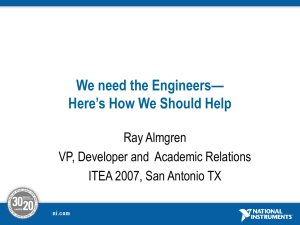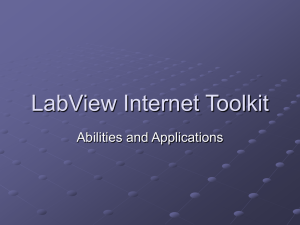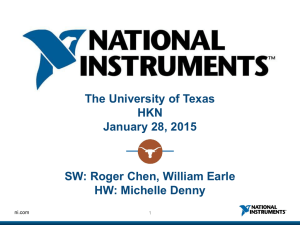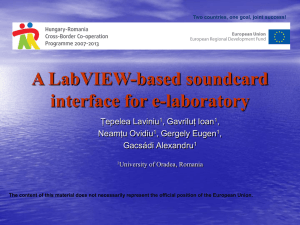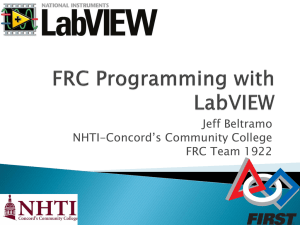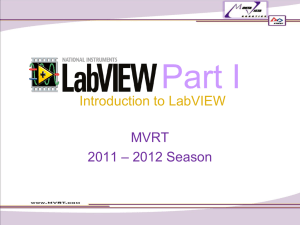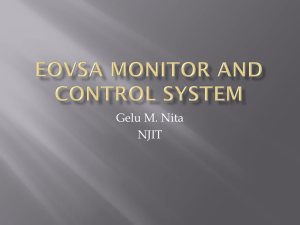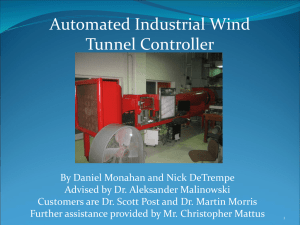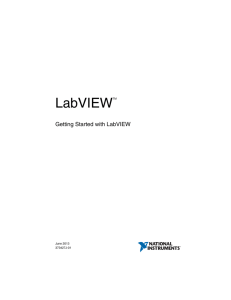Sensors and Insrument
advertisement
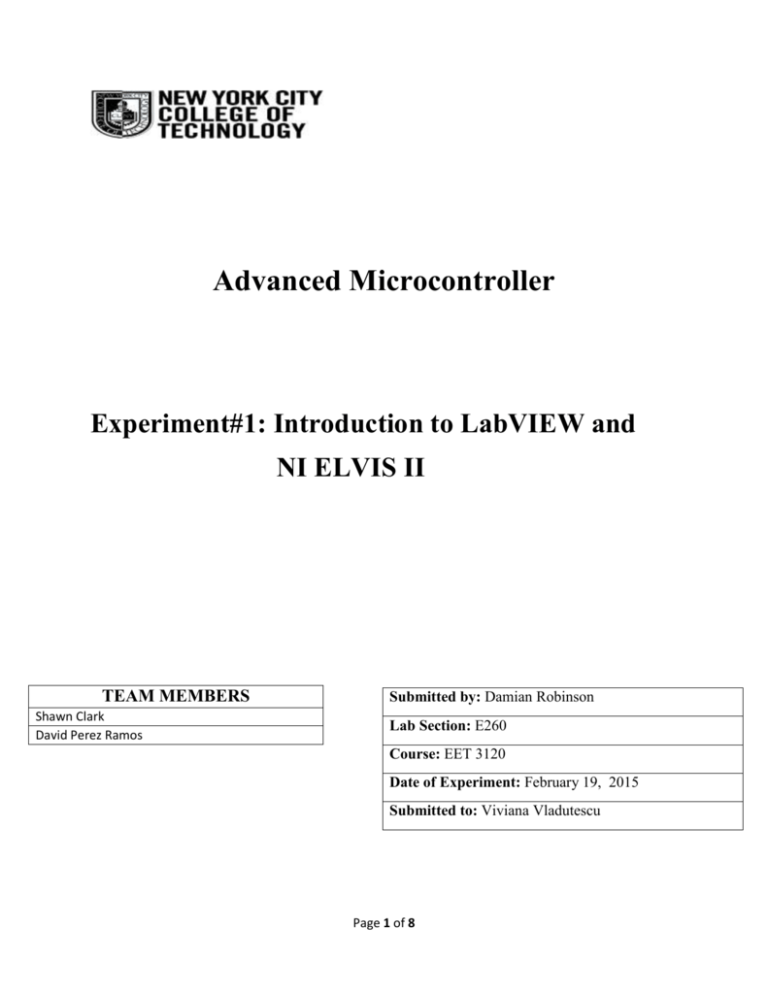
Advanced Microcontroller Experiment#1: Introduction to LabVIEW and NI ELVIS II TEAM MEMBERS Shawn Clark David Perez Ramos Submitted by: Damian Robinson Lab Section: E260 Course: EET 3120 Date of Experiment: February 19, 2015 Submitted to: Viviana Vladutescu Page 1 of 8 TABLE OF CONTENTS CONTENT PAGES Introduction 3 Objective 3 Theory 4 Procedure 5 Results 6-8 Conclusion 8 Page 2 of 8 INTRODUCTION This laboratory experiment introduces us to the basic of using LabVIEW. This is a computer based instrumentation software consist of a computer and peripherals. It uses the computer for data acquisition, processing, measurement, display and communication. LabVIEW (short for Laboratory Virtual Instrument Engineering Workbench) is graphical in nature and used to develop sophisticated measurement and test. The system use icons and wires that resembled a flowchart. OBJECTIVE The purpose of this experiment is to learn how to do graphical programming using LabVIEW, and to know the functions and their meaning. Also from this experiment we should be able to build an instrument for measurement and test. Components 1. Desktop Computer 2. Lab View software 3. Lab Manual Page 3 of 8 THEORY LabVIEW is the short for Laboratory Virtual Instrument Engineering Workbench, it is a programming environment in which you can create programs using graphical notation connecting functional nodes through wires, though which data can flow. The graphical programming language used in LabVIEW is call “G” (Graphical). LabVIEW can reduce the time it normally takes to write a program to a matter of hours. LabVIEW has an extensive libraries of functions and subroutines to help with programming. LabVIEW versatile graphical user interface and its ability to program so easily is ideal for simulations, general programming, take measurements, analyze Data, and present results to users. LabVIEW allows the user to create exactly the type of virtual instrument needed, when the user need it at a fraction of the cost of traditional instruments. When the user needs change, he or she can modify the virtual instrument in moments. Virtual Instrument Panel and Diagram Creating a VI (Virtual Instrument) in LabVIEW two windows are opened the “panel” and the “Diagram” as shown in the figure below. Panel Window ---- represent the user interface. This window enables the visualization of the result given by running the program. Diagram Window ---- this represent the source code of the application. In LABVIEW instruction and commands are called “Functions”. Page 4 of 8 PROCEDURES This is the first experiment that will introduce us to graphical programming. The purpose of this experiment to program in LabVIEW. We will solve first degree equation using arithmetic operations. First degree equation is also known as a linear equations and it takes the form shown below. 𝑎∗𝑥+𝑏 =0 a and b are coefficients of the equations. x is the equation’s unknown. Rearrange the equation to find the solution in the form. −𝒃 𝒙= 𝒂 Use LabVIEW to build the virtual instrument shown below. Lab Manual EET 3120 – compiled, edited and developed by prof. Viviana Vladutescu page 16 Page 5 of 8 RESULT Problem # 1 𝒂 ∗ 𝒙 + 𝒃 = 𝟎 ……………………….. Solve for x 𝒙= We got −𝒃 𝒂 Calculation Table. 𝒙= b a X 6 4 -1.5 −𝒃 𝒂 3 6 -0.5 Page 6 of 8 -12 4 3 Problem 2 𝟏 - x = x0 + vo 𝒕𝟏 + a𝒕𝟐 ………………………………………………..Solve for a 𝟐 The instrument below is the LabVIEW representation of transposed acceleration formula (𝑎 = 𝟐(𝒙−𝑿𝒐−𝑽𝒐∗𝒕𝟏) 𝒕𝟐 ). Diagram Window Panel window Result is displayed in the Indicator label “a”. The diagram window shows the code or instruction that compute the result. Page 7 of 8 CALCULATIONS 1. Adapt the application to implement Equation (1-4) to find the necessary time, T1. X1= VoT1+Xo VoT1+Xo-X1 = 0 aT1+b=0 T1= −𝒃 𝒂 = T1= −𝟐 𝟒 −. 𝟓 2. Modify the application to study the uniformly accelerated linear motion using equation (1-5) which follows: 𝑿 = 𝑿𝒐 + 𝑽𝒐𝑻𝟏 + 𝟏/𝟐𝒂𝑻𝟐 Solving for a: 𝒂= 𝟐[𝒙−𝒙𝒐−(𝒗𝒐∗𝒕𝟏)] 𝑻^𝟐 - Plugging the values in the equation we get: X=4; XO=2; V0=3; t1=1; 𝒂= t=2; t^2=4 𝟐[𝟒−𝟐(𝟑∗𝟏)] 𝟒 = -.5 CONCLUSION This laboratory experiment demonstrates the basic construction of an instrument, its computation and display of result. The construction of the instrument is done in the LabVIEW software that used computer base graphical icons and wire that resemble a flowchart. The LabVIEW system consists of a computer, hardware for data acquisition and the computer based instrumentation software. REFRENCES:Lab Manual EET 3120 – compiled, edited and developed by prof. Viviana Vladutescu Page 8 of 8
